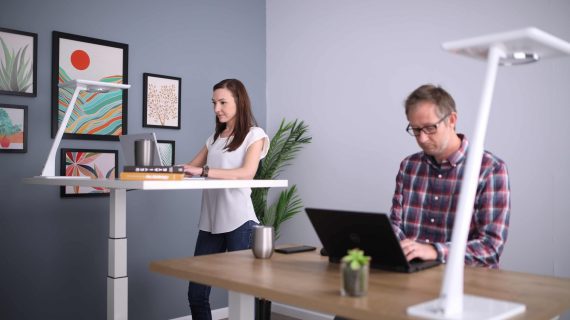The complete guide to standing desks
Our perception of the perfect office environment is constantly changing; new information is always being released on how best to enhance employee productivity and wellbeing, so it’s important, as an employer, to be privy to these trends. Standing desks have been a legitimate alternative to traditional desks for a few years now, and the demand is only growing. Writers such as Charles Dickens, Ernest Hemmingway and Vladimir Nabokov were all in favour of the standing desk, and recent studies show that a whopping 43% of people reported a large increase in productivity after utilising them, amongst other benefits.
What is a standing desk?
The standing desk is a relatively straightforward, yet effective, invention. It allows the user to work whilst standing upright. Also known as a sit-stand desk, most modern versions tend to be adjustable - so you can easily alternate between standing and sitting. Any potential accessibility issues can be remedied with a variety of accessories, for example an anti-fatigue mat if you tire easily, or an arm rest.
You really do get the best of both worlds with a standing desk. Office work is varied at times and you may prefer to reply to emails or notifications whilst sitting down, switching to a standing position when completing a group project or getting involved in a high energy brainstorming session. Users have complete flexibility to swap between sitting and standing at their leisure, improving both comfort and productivity.
How to use a standing desk
Using a standing desk may seem daunting at first, but it’s easy to get the hang of. You should stand fully upright, and avoid slouching. To maximise the benefits, it is important to maintain good posture, but also to remain comfortable while you work. A good standing desk should not distract you from your work, but rather help you stay engaged and productive.
How high should a standing desk be?
To efficiently utilise a standing desk, you should be aware of two key elements - the height of the raised desk and the duration you are standing for. Ideally, your desk should not be so low that it impacts your posture - that would defeat one of the purposes of standing - but also not so high that navigating and typing becomes a strain.
How long should you stand at a standing desk?
Whilst spending all day sitting may be detrimental to your health - this certainly doesn't mean you should spend all day standing instead. Alternating between the two is most beneficial; a rough 1:1 ratio for standing/sitting will do the trick. If you work a typical 9-5, it would be advisable to stand for around 4 hours of the day, but make sure that you take a load off every hour or so.
Benefits of using a standing desk
Several studies suggest that sitting for prolonged periods can increase your risk of chronic health problems, mainly heart disease and diabetes. Comparatively, the use of a standing desk helps you burn excess calories, can lower the risk of heart disease by up to 147%, and eradicates back pain caused by bad posture when sitting. Another study showed that 87% of those who used standing desks claimed they felt more energised, so if there’s any reason for you to invest in one, it’s surely this.
A standing desk may also be a more suitable choice for someone who finds themselves spending most of their day standing up, or alternatively, for someone who can’t find much time for exercise. Although you may not think it possible, there are plenty of ways to stay fit with a desk job - it’s all about understanding how to optimise your setup.
There’s little doubt that a standing desk can help to create a happier, healthier environment to work in, so why not take a look at our collection today? Get in touch with us to find out how our experienced team of office fit out experts can help match you with the best furniture for your business.

